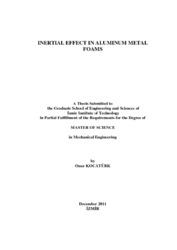Please use this identifier to cite or link to this item:
https://hdl.handle.net/11147/3174Full metadata record
| DC Field | Value | Language |
|---|---|---|
| dc.contributor.advisor | Güden, Mustafa | en |
| dc.contributor.author | Kocatürk, Onur | - |
| dc.date.accessioned | 2014-07-22T13:51:01Z | - |
| dc.date.available | 2014-07-22T13:51:01Z | - |
| dc.date.issued | 2011 | en |
| dc.identifier.uri | http://hdl.handle.net/11147/3174 | - |
| dc.description | Thesis (Master)--Izmir Institute of Technology, Mechanical Engineering, Izmir, 2011 | en |
| dc.description | Includes bibliographical references (leaves: 68-71) | en |
| dc.description | Text in English; Abstract: Turkish and English | en |
| dc.description | xi, 71 leaves | en |
| dc.description.abstract | In this study, Al tubes, Al foams of different types, Al sandwich plates of various configurations (orientations) and brittle glass foam samples were quasistatically reloaded in order to assess any micro inertia effect on the deformation stresses. Al foams tested quasi-statically were further reloaded (interrupted test) in Split Hopkinson Bar (SHPB) at dynamic strain rates in order to see effect of strain rate on micro inertia effect. Al empty tubes experienced micro inertia independent (Type I) deformation behavior in lateral compression and micro inertia dependent (Type II) deformation behavior in axial compression. The lack of strain rate sensitivity of the tested Alulight (AlSi10) closed cell Al foams (Al/Si) produced through powder route within the studied strain rate regime was attributed to the foam cell wall fracture during cell wall buckling. While Al foams with and without SiC addition showed micro inertia effect through progressive cell wall bending. In accord with these observations, Al and Al/SiC foams showed the strain rate sensitive, while Alulight foams showed strain rate insensitive plateau stress in the SHPB compression tests. The layer configuration/orientation was shown to affect Al sandwich plate deformation. Progressive bending of the interlayer fins resulted in strain rate depending crushing stress, while shearing of the interlayer resulted in strain rate insensitive deformation stress. As was expected, the strength enhancement was not seen in glass foam specimens tested as the cell walls were fractured under compressive loads. Finally, a simple testing method was shown to investigate micro inertia effect in hollow and cellular Al structures. | en |
| dc.language.iso | en | en_US |
| dc.publisher | Izmir Institute of Technology | en |
| dc.rights | info:eu-repo/semantics/openAccess | en_US |
| dc.subject.lcsh | Aluminum foam | en |
| dc.subject.lcsh | Metal foams | en |
| dc.subject.lcsh | Foamed materials | en |
| dc.subject.lcsh | Sandwich construction | en |
| dc.subject.lcsh | Inertia (Mechanics) | en |
| dc.title | Inertial effect in aluminum metal foams | en_US |
| dc.type | Master Thesis | en_US |
| dc.institutionauthor | Kocatürk, Onur | - |
| dc.department | Thesis (Master)--İzmir Institute of Technology, Mechanical Engineering | en_US |
| dc.relation.publicationcategory | Tez | en_US |
| item.fulltext | With Fulltext | - |
| item.openairecristype | http://purl.org/coar/resource_type/c_18cf | - |
| item.openairetype | Master Thesis | - |
| item.cerifentitytype | Publications | - |
| item.languageiso639-1 | en | - |
| item.grantfulltext | open | - |
| Appears in Collections: | Master Degree / Yüksek Lisans Tezleri | |
Files in This Item:
| File | Description | Size | Format | |
|---|---|---|---|---|
| T000989.pdf | MasterThesis | 6.54 MB | Adobe PDF |  View/Open |
CORE Recommender
Page view(s)
120
checked on Oct 14, 2024
Download(s)
112
checked on Oct 14, 2024
Google ScholarTM
Check
Items in GCRIS Repository are protected by copyright, with all rights reserved, unless otherwise indicated.